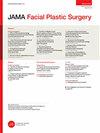Categorization and Analysis of Nasal Base Shapes Using a Parametric Model.
Q1 Medicine
引用次数: 4
Abstract
Importance Nasal base view is important for rhinoplasty analysis. Although some descriptors of nasal base shape exist, they are largely subjective and qualitative. Objective To evaluate a parametric model of nasal base shape and compare it with categorization by surgeons to create an objective classification system for clinical evaluation and communication. Design, Setting, and Participants Retrospective cohort review of deidentified photographs of 420 patients evaluated for possible facial plastic surgery at a tertiary care academic medical center between January 2013 and June 2017. The nasal bases were classified into 6 shape categories (equilateral, boxy, cloverleaf, flat, round, and narrow) via visual inspection. The contour of each nasal base was traced using MATLAB software (MathWorks Inc). The software then performed a curve fit to the parametric model with output of values for 5 parameters: projection-to-width ratio, the anterior-posterior positioning of the tip bulk, symmetry, degree of lateral recurvature of the nasal base, and size. The differences among shape categories for each parameter were analyzed using 1-way analysis of variance. Pairwise comparisons were then performed to ascertain how the various shapes differed. Finally, a multinomial logistic regression model was used to predict nasal base shape using parameter values. Data were analyzed between April 2017 and January 2018. Main Outcomes and Measures An algorithm that categorized nasal base shapes into 6 categories. Results The 420 nasal base photographs of patients evaluated for possible plastic surgery were categorized into 1 of 6 categories; 305 photographs were readily classified, and the remaining 115 were termed unclassified and were categorized. For both the classified and unclassified nasal base groups, there were statistically significant differences between projection-to-width ratio (classified, F5,299 = 21.51; unclassified, F4,100 = 10.59; P < .001), the anterior-posterior positioning of the tip bulk (classified, F5,299 = 3.76; P = .003; unclassified, F4,110 = 4.54; P = .002), and degree of lateral recurvature of the nasal base (classified, F5,299 = 24.14; unclassified, F4,100 = 7.21; P < .001). A multinomial logistic regression model categorization was concordant with surgeon categorization in 201 of 305 (65.9%) cases of classified nasal bases and 38 of 115 (33.0%) unclassified nasal bases. Conclusions and Relevance The parametric model may provide an objective and numerical approach to analyzing nasal base shape. Level of Evidence NA.基于参数化模型的鼻基形状分类与分析。
重要鼻底视图对鼻整形术的分析很重要。尽管存在一些关于鼻底形状的描述,但它们在很大程度上是主观的和定性的。目的评估鼻基底形状的参数模型,并将其与外科医生的分类进行比较,为临床评估和沟通创建一个客观的分类系统。设计、设置和参与者对2013年1月至2017年6月期间在三级护理学术医疗中心评估的420名可能进行面部整形手术的患者的未识别照片进行回顾性队列审查。通过视觉检查将鼻基底分为6个形状类别(等边、方形、三叶、扁平、圆形和狭窄)。使用MATLAB软件(MathWorks Inc)追踪每个鼻基部的轮廓。然后,该软件对参数模型进行曲线拟合,输出5个参数的值:投影与宽度比、尖端体积的前后位置、对称性、鼻基部的侧向下弯程度和大小。使用单向方差分析来分析每个参数的形状类别之间的差异。然后进行成对比较,以确定各种形状的差异。最后,使用多项逻辑回归模型,利用参数值预测鼻基底形状。对2017年4月至2018年1月期间的数据进行了分析。主要结果和测量将鼻基形状分为6类的算法。结果420张可能进行整形手术的患者的鼻基照片被分为6类中的1类;305张照片很容易被分类,其余115张被称为未分类照片并被分类。对于已分类和未分类的鼻基组,投影宽度比(已分类,F5299 = 21.51;未分类,F4100 = 10.59;P < .001),尖端体积的前后定位(分类,F5299 = 3.76;P = .003;未分类,F4110 = 4.54;P = .002),以及鼻基部的侧向下弯程度(分类,F5299 = 24.14;未分类,F4100 = 7.21;P < .001)。在305例(65.9%)已分类的鼻基底病例中,201例(115例)未分类的鼻底病例中,多项逻辑回归模型分类与外科医生分类一致。结论与研究该参数模型可以为分析鼻底形状提供一种客观的数值方法。证据等级NA。
本文章由计算机程序翻译,如有差异,请以英文原文为准。
求助全文
约1分钟内获得全文
求助全文
来源期刊

JAMA facial plastic surgery
SURGERY-
CiteScore
4.10
自引率
0.00%
发文量
0
期刊介绍:
Facial Plastic Surgery & Aesthetic Medicine (Formerly, JAMA Facial Plastic Surgery) is a multispecialty journal with a key mission to provide physicians and providers with the most accurate and innovative information in the discipline of facial plastic (reconstructive and cosmetic) interventions.
 求助内容:
求助内容: 应助结果提醒方式:
应助结果提醒方式:


